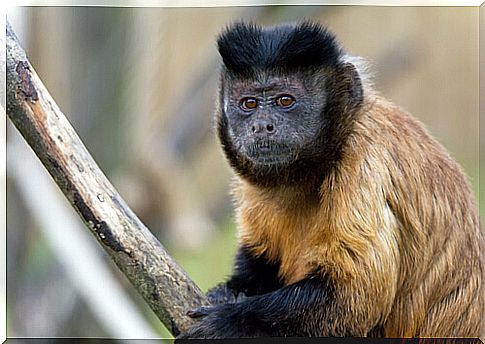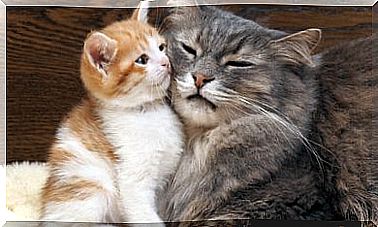Curiosities Of The Hard-headed Capuchin Monkey

The curiosities of the hard-headed capuchin monkey are surprising; Although there are several species of capuchin monkey, this is probably the best known. Present in numerous movies and series unfortunately for this animal, it has surprising behaviors.
Capuchin monkey curiosities: a question of ridges
One of the curiosities of the hard-headed capuchin monkey has to do with ridges, and that is that it has two: on the one hand, the robust capuchin monkeys belonging to the genus Sapajus differ by having a sagittal crest on the skull, specifically in the case of the males.
But, in addition, another of the curiosities of the capuchin monkey is that they develop a crest of black hair, which is especially prominent in males, and even more in the one that stands out with the dominance of the group. This species intimidates by emitting vocalizations and raising the eyebrows, which causes the toupee to move when they are raised.
Capuchin monkey curiosities: destructive feeding
These animals are omnivores and, although most of their diet is based on fruits, roots or plants, the truth is that insects, reptiles and amphibians are also part of their diet, as well as small mammals or even eggs.
But one of the curiosities of the hard-headed cappuccino is that it expends a lot of physical energy in its feeding: it spends the day beating nuts, breaking branches, pulling the bark of trees, lifting rocks or biting hard fruits.

Capuchin monkeys also know where to find all their food, thanks to the fact that they have a large brain for their small size, which allows them to have a mental map of where to find the right resources.
Capuchin monkey curiosities: baths with onion
Baths with onions and other materials are an almost instinctive behavior: lime or other citrus fruits, insects or some plants with antiparasitic principles, are used by hard-headed capuchin monkeys in the wild.
It is believed that this behavior has several functions: on the one hand, the bath with these elements is antiparasitic, and repels ticks and mosquitoes. On the other hand, it reinforces social relationships, since the cappuccinos get together and share the onion as much as possible.
This also allows them to reach areas where they cannot. However, the capuchin monkey, like other South American primates, has a prehensile tail, with which it can easily reach most of its body.
Capuchin monkey curiosities: use of tools
The hard-headed capuchin monkey is known for its great intelligence, as it is one of the best examples of the use of tools in animals. They have been observed using natural containers for water, sticks to reach for food, sponges to absorb liquids, and even natural hammers and chisels.
Another example of the curiosities of the capuchin monkey in terms of the use of tools is how they use stones to excavate for tubers, and even prepare stones using other stones to later use them. This behavior has only been seen in humans, great apes, and capuchin monkeys, giving us an idea of their extreme intelligence.

Capuchin monkey curiosities: money and justice
Capuchin monkeys have even been shown to understand the concept of money after training. That is, they understood that symbols and tokens were equivalent to food and had a value. Thus, the capuchin monkeys began to give a token value to food and gave researchers what they believed to be consistent.
These primates also understand the concept of justice: after rewarding two capuchin monkeys with grapes and cucumber for the same task, the winner with the cucumber got angry with the researcher and threw it in his face.
Capuchin monkey curiosities: relationship with other monkeys
Capuchin monkeys have even shown friendly relationships with other primates in the wild: the squirrel monkey and the capuchin monkey team up to hunt insects and obtain other food. Thus there are more monkeys watching in the presence of predators, as both have a common enemy: the raptors of the Amazon rainforest.

It has been found that the capuchin monkeys and squirrel monkeys can pass together to half the day, although they tend to sleep separately. In captivity they have also lived together and, although the entry of the squirrel monkeys has been limited so that the capuchins do not enter, the squirrel monkeys go to the capuchin bedroom to socialize.
Curiosities of the capuchin monkey: a complex communication
Among the curiosities of the capuchin monkey, its oral communication stands out, and it is that they have several vocalizations to maintain contact between the members of the group, alert calls or even threats.
Male capuchin monkeys have herding behaviors, in which they run to hug and reunite while squealing with happiness ; this behavior has not been observed in females, and it is believed that it strengthens their group relationships.

Capuchin monkey curiosities: a threatened species?
The capuchin monkey has shown that, despite the permanent harassment it has received, it adapts brilliantly to the human presence. It is one of the few primate species that is not yet threatened, despite the fact that humans have actively exploited its ecosystem. In fact, it is the primate with the largest distribution in South America after humans.
They have also been captured for the film industry, show business and even mascotism. And it is that their facial expressiveness and popularity has meant that these animals have been exploited as actors and pets, which is why a monkey with clothes is not funny and its place is the jungle. Never a house or a set.









